Text
Bonus Post: Seoul Korea’s Epic Airport and Layover.
1. This airport is beautiful.
2. They have a nap room and free public showers and a robot.
3. They have a digital gym
4. I ate ice cream at 6am.






0 notes
Text
Day 14, Part 2
At around 4:15 Thuy takes us to the Opera House to pick up tickets for our 1 hour show called Teh Dar. It was her recommendation and I’m terribly excited because I want to see inside. This is when we bid farewell (with a hug) to Thuy as she needs to make a trip out to see her family for her brother’s death day. We have some time before the show however so we take a stroll around and walk by the giant Ho Chi Minh statue in front of a french built city hall. Continuing straight we peruse through the Ben Thanh Market which has been around since 1914. It a a mix of souvenirs and fish and coffee and food stalls. We saunter back to the Opera House for our special welcome cocktail and a brief theatre tour before the show.



The structure itself was built in 1898 but the first Vietnamese performance was in 1918. From the opera house you can easily see famous hotels like the Caravelle and the Continental. In 1944 it was bombed during WW2 and in 1955 used to seat the lower house of government in Vietnam. In 1975 they restored the building as a theatre but it was further renovated from 1996 to 1998. This renovation decreased the seating capacity from 800 to 468. In 2012 it became a national relic of Vietnam.



The show itself is spectacular and hard to accurately describe. It’s part dance, part acrobatics, part traditional music. The performers use bamboo poles and even the round fishing boats we tried in Hoi An. Teh Dar, the show’s name is from an ethnic language from the western highlands and means “to go in a circle.” It was a perfect finale for our last night.
We don’t have much time and make our way to Ngon restaurant. A busy. Beautiful spot covered in green. Surrounding the seating area are all the cooking stations, meant to almost resemble a market. The menu is extensive. I notice that the placemats are the same as the very first lunch we ate back in Hanoi. The restaurant has two Vietnam locations (also one in Cambodia and one in Berlin if you’re in the mood for Vietnamese food!) and it’s very fitting that our trip has truly come full circle. We get pork spring rolls, pork in clay pot, grilled pork and a salad with banana flower, star fruit and beef. Kerran has a fresh coconut and I have a pomegranate juice. We don’t have time for dessert unfortunately. We have to meet the driver and Thuy’s adorable friend at the Caravelle Hotel Lobby to head to the airport.




The only bad part about vacation is the end. Don’t get me wrong I love my job, but on the back end of vacation I always find it hard to get back in my groove, I wish it could last indefinitely. If I could always be traveling, I probably would.
Thank you to everyone who sent recommendations this trip especially Grandma Ellen and Papa Donals, to AsiaDesk for creating a ridiculous 2 week trip, to all our tour guides and drivers and to Kerran who survived an action packed trip. Until our next adventure..
0 notes
Text
Day 14, April 20, 2019: Floating Markets, Saigon and Homeward Bound
Today is a bright and early morning. We meet Thuy at 6:30am and walk just to the back of our hotel to board a private colorful motored wooden fishing boat that’s now been adapted for tourists. We take a thirty minute ride toward the areas buffet floating market, Cai Rang.
On the way to the floating market we pass by fish markets on either side of the river (on land). While they look close, there is no bridge here to separate them and these markets require more frequent visits given the need to purchase fresh fish. The Cai Rang Market is more of a whole-sale experience dedicated to fruit and produce. It runs daily beginning at around 5, and going until 10. Vendors will come from as far as 100km awayband fill their boat with one type of produce of perhaps many. By the time we arrive at 7 you can see smaller boats departing the markets with carried supplies to stock their stores. The vendors however may anchor at the market for a week while they rid themselves of their supply. Generally we find that boats with like products anchor closely together. It’s similar to the apple section in the grocery store. Boats designate the produce they are selling by either placing items on top of their boat or hanging them from a bamboo boat. There are smaller “convenience store” boats with beers and drinks selling mostly to vendors and even smaller boats with meats on sticks etc to feed those while they are here. Today there is a pumpkin section, a taro section, boats filled with pineapples and boats with watermelons among others.



We circle the market and on our way out stop at the last boat selling pineapples and jump atop the roof. We watch the woman on her boat cut the pineapple and we eat it corn-on-the-con style. Sweet. Fresh.
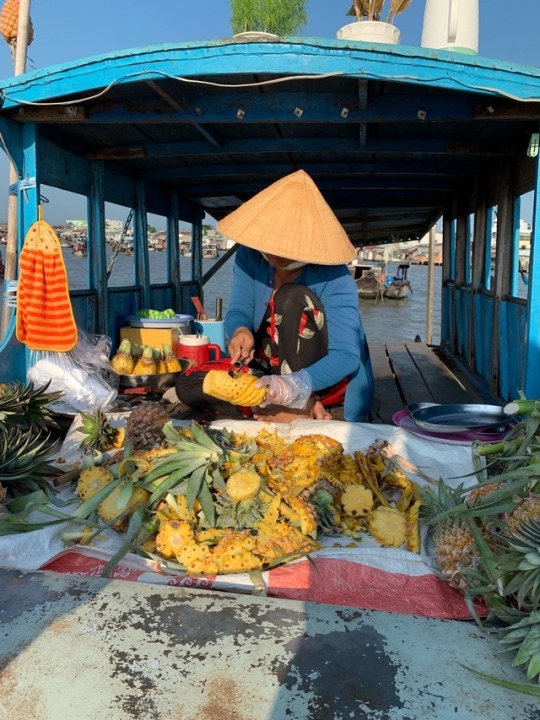

After the market we sail back to the Victoria Can Tho hotel and are back for breakfast around 8am. We shower and check out of the beautiful hotel by 10am and are on the road back for our 4 hour drive to Saigon.
On our way out we pass the customary big mall and office building owned by Vin—the richest man in Vietnam whose real estate is quite literally unavoidable. We cross a giant suspension bridge which has only been here for 7 years. Before, Thuy tells us she could wait almost 2 hours for the ferry!
About halfway back we stop at a roadside eatery tucked behind a fence that’s not easy to spot. They definitely don’t have an English menu, if they have a menu at all. It’s the kind of place that doesn’t have a western toilet. Our driver and Thuy eat with us, which is really really good because I think Thuy orders almost everything the place makes! We’re the only tourists here. This place specializes in clay pots so we get frog legs, eel, and spare ribs in a pot. We have rice and two soups, both with fish-one with the requisite cabbage type leafy greens and one with green squash. We also get bitter melon with eggs. I accumulate a bowl full of bones. The owner is thrilled to see westerners here and (through Thuy) constantly asks if we enjoy our food. For dessert we try guava with chili salt. Gauge is almost apple like, dense and fibrous and the chili salt really makes the flavors more complex. Predictably, I am so full!




After lunch we are basically in a food-coma and I take a mini nap as well as draft a few of these blog entries. After about two hours of driving we are back in Saigon for a few more hours before our 11:30pm flight home.
We drive through historic China Town, also called Cho Lan, which literally means “big market.” Its instantly obvious why. We drive past the gigantic wholesale Binh Tay Markey which has just been recently renovated. Past this market are shops and shops of herbal medicines. We take a left part shops full of mechanical scissors. Thuy tells us that most homes here go largely unchanged because of people’s fear to mess with good feng shui. She also tells us the population mainly speaks Cantonese, not Mandarin. We take a short stop to visit Thien Hau Pagoda. This was originally built in 1769 and honors the goddess of the sea. Thuy tells us that it’s believed that the goddess died a virgin at 27, and that she protects the fisherman of the sea. In the middle there is an altar to burn things like paper money -meant to signify wealth for those in the afterlife. Buddhists in Vietnam will often do this —burn offerings of clothes or paper money at someone’s grave on their death anniversary—a day far more significant than a birthday, given the strong culture of ancestor worship. There are pink papers on the right wall denoting donations and who has given them, and those too are burned all together annually.

After this we stop at Mr.Biker, a bike shop on the main drag in District 1 for one specific purpose: to buy a Vietnam bike jersey. While we didn’t cycle top to bottom we think our hilly runs justified the well priced Jersey!
Then we visited Marou Chocolate—a chocolate shop opened and run by two french men after discovering the quality and diversity of cocoa plants through southern Vietnam. The shop itself looks like it should be in NYC, and the prices suggest they same. We spend more than we care to admit on chocolate because we want to try so many thing. We get a few truffles for our driver, Thuy and certainly us. The french baked goods and desserts look positively mouthwatering but we use restraint and split a cookie. I’m just realizing now (a day later) that it wasn’t kosher for Passover. I’m usually maniacal about keeping it and will be as soon as I land in NYC. I’ve done as well as I can given the circumstances.
0 notes
Text
Day 13, Part 2
Our first stop is a unique Buddhist pagoda. A Pagoda is a place where Buddha is worshipped vs other deities. By this point in the trip we feel like we’ve seen enough pagodas and that almost are similar and have dragons and mosaics. We’re hesitant to see another, but boy how wrong we are, this one is certainly different.
I need to preface this section that I really don’t want to come off disrespectful to any religious place of worship and that’s not my intention here with my description. This Pagoda is like any other I’ve seen. Everything about this place is dream like, dream like in the vein of Disney and Lisa Frank. There’s a tree-house like structure in the shape of a locust. Surrounding a temple is an elevated walkway that looks like lily pads. Around the central temple is a circular ring of petals. This is lotus temple. Unfortunately we were unable to photograph the inside of the actual Pagoda. It’s not red and gold and dark wood like others. It’s a massive ceiling in bright pastel-like colors. It looks like unicorns and Care Bears and cotton candy. It’s fun. It’s light, and it’s actively maintained by monks. In fact, we were fortunate to even get inside. There is incense and countless lillies inside that make the room smell just like it looks.

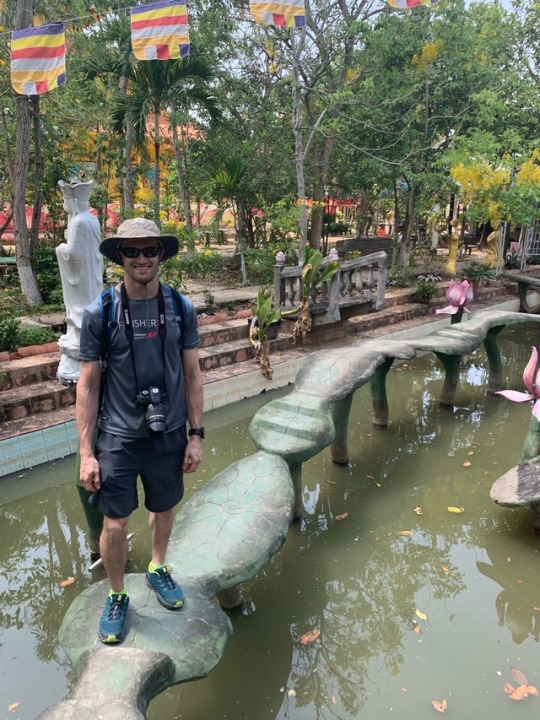
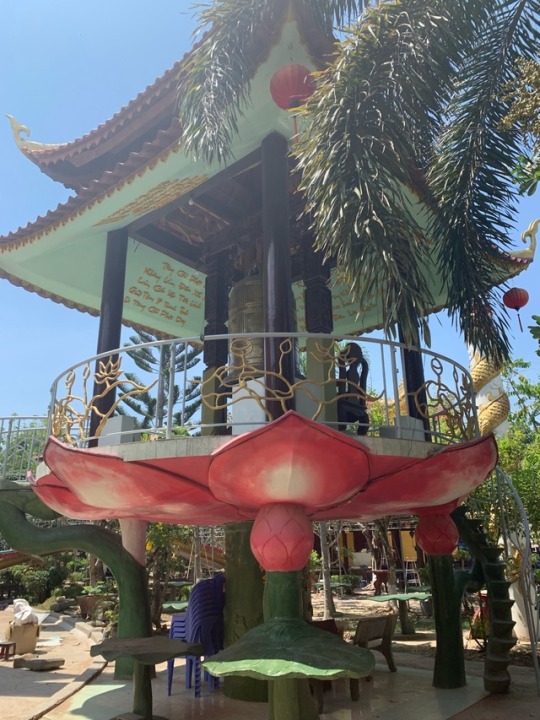
After the unique Pagoda we get back on the moto-taxi and ride toward town where there are more motorbikes and some big homes. Today is in the high 90s. We are on our way to lunch at a local home. True to Thuy’s promise, we haven’t seen a single tourist all day.
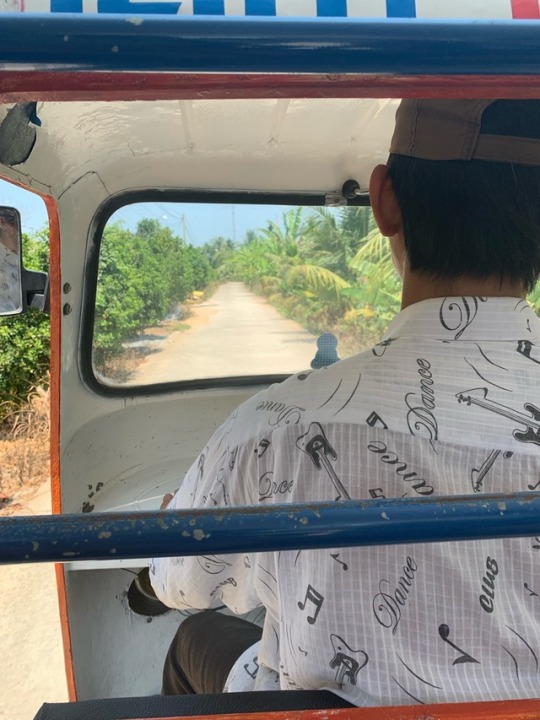
We go back down a more secluded street on the outskirts of Ben Tre, and find our way to the small, one bedroom home of a jolly couple and their two children. When we arrive the two boys are just heading to school. In small towns like this younger kids especially go to school during the morning or afternoon sessions, 7-11 or 2-5. Thuy tells me differently than I heard from Viet in Hoi An—she says education beyond primary school is not compulsory. It’s a bit unbelievable To me that this whole family resides in one room. Like the other homes we’ve been to, the bathroom is at the back and detached from the home. Some are esteem style, but many like this one is western. There is also a sink toward the front to wash your hands—outside the house.
The couple cuts a handful of coconuts right from the tree and we sip on them over another absurd feast of foods. This is the area most famous for coconuts in the country. There is a banana flower salad, clay pot pork, a traditional Mekong Delta soup with giant shrinks and pineapple, there’s a chicken dish and more.

The couple is smiley and jolly and laughs when the husband sprays cold water on the roof and it spills onto the wife inside. There’s an old large Toshiba tv and a new one too. Here life is simple, not easy, but simple. The couple also steams Bananas for us. Thuy says she’s never received steamed bananas here before. These are so bitter they can only be eaten this way. On our way out, the family that has so little, sends us away with some handpicked oranges (which by the way, are in green peels in Vietnam.)

We sadly bid farewell and ride our moto-taxi to a more Main Street where we meet our driver for the first time since dropping us off at the boat this morning. You can see tourism start to get a footing in Ben Tre, but luckily we don’t see much of it. The rest of the trip to our home base of Can Tho, the largest city in the Delta will be by car.
The Mekong River is 4500 meters long and meanders its way through many countries including China, Myanmar, Laos, Thailand, Cambodia and finally, Vietnam before it empties into the East China Sea. In Vietnam 9 branches break out from the source river, but the Mekong is the most famous. For the remaining two hours of the drive I nap a little. We drive through the cities of My Tho and Vinh Long before we reach Can Tho. Our final hotel of the trip is a bit separate from the main city, but only a ten minute walk away. The Victoria Can Tho Resort reminds me of the charming places we stayed in Bali.

It is probably the hottest it’s been all trip. It’s in the 90s and equally humid. The massive pools of the property are calling our names and we go for a swim. The water is the hottest pool water ever, it’s basically a hot tub. It’s been warmed up all day from the heat.
We walk over the pedestrian bridge toward town for dinner. The pedestrian bridge has two giant lit up Lotus flowers. Lotus flowers are the National Flower of Vietnam. They are important to Buddhism and they really are stunning. We peruse the local night market which is mostly clothes and shoes. The nearby tourist night market however has what we’re looking for—a shirt for Kerran to wear tomorrow. Just beyond the market is a riverside restaurant called Sao Hom.
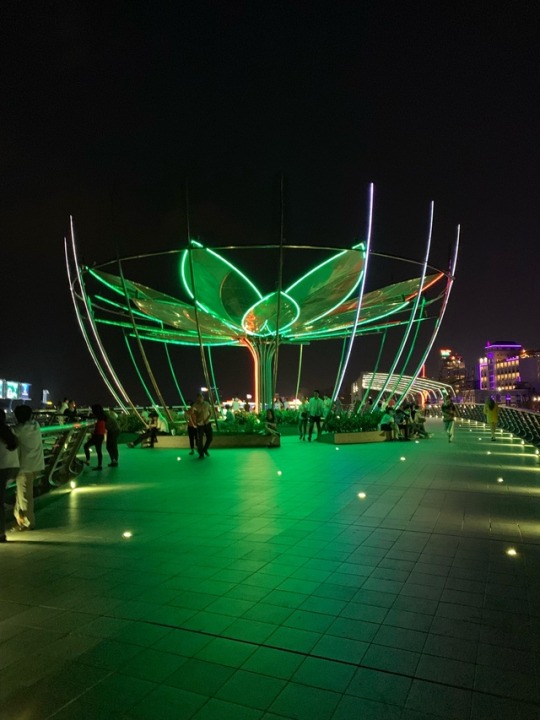
Tonight is Passover, my favorite Jewish holiday, so I downloaded a short Seder for us to read over dinner. Kerran and I pass the phone back and forth and conduct a pretty sub par abbreviated Seder. The only key items we have is parsley and wine but we make do. My pork in clay pot is bad but Kerran’s chicken with ginger is delicious. That’s karma for offering pork on Passover. We also start with pumpkin flower dumplings (maybe not kosher for Passover!) with pork and those are good. Tonight is the first night we don’t share a dessert (Kerran gets a crepe and that’s just not at all pesadich!) I get vanilla ice cream. After the fourth glass of wine we cheers to grandma Mary before walking home and calling it a night. We have an early morning ahead!
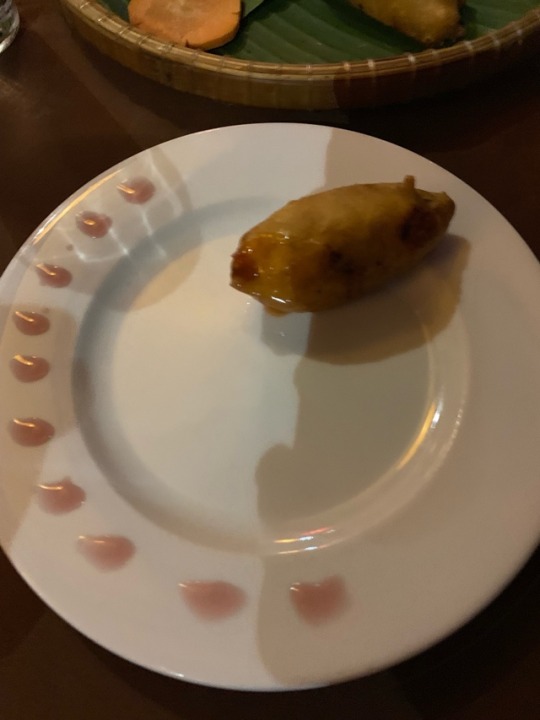

0 notes
Text
Day 13, April 19, 2019 Mekong Delta
It’s been a swift stay in Saigon but an action packed one none the less. After another rooftop breakfast at the Majestic hotel we finish packing and check out at 8:30am. As you can tell we’ve had a lot of early mornings this trip, but mostly early nights too. Vietnam starts their day early. We meet our speed boat in the same location as yesterday and are accompanied by another guide from Fisheye tours. Today, instead of heading north, we’re traveling south toward the Mekong Delta, the rice capital of Vietnam. Vietnam is the third biggest exporter of rice in the world. On our way we pass Saigon port and travel below many new bridges. Just a few years ago the only way to cross the boat was by ferry. While these do exist today, a series of bridges have also been constructed in some parts of the Saigon river. After Saigon part we pass the poorer section of the river with numerous house boats and riverside shacks that are deteriorating and made of run. The government is slowly trying to buy up the riverfront property and relocate the poorer families to make way for construction. You can see it happening already. In general here you will see nicer neighborhoods directly next to poorer ones.

In order to arrive at the Mekong River we will take a series of other rivers and canals. Our first stop is about 35 minutes from where we departed and is a small very very local market. The theme of the day will be not seeing other tourists. This is even more local and remote than any other market we’ve seen. They are selling fruit and fish heads and every possible cut of chicken. I have to admit it is kind of funny when you think about it: we’re visiting people and snapping photos in what they consider akin to their local super market.

We get back in the boat in the brackish water and we are surrounded by lush thick greenery, mostly water coconuts which are planted to prevent erosion. Egrets glide gracefully along the water. This is what you think of when you think of postcard Vietnam. You feel in another time here, the banks of the river are not fully developed. I wonder how long before buildings flank both sides. I hope the rapid growth doesn’t kill the magic of this place. I hope the changes here are for good—less pollution, more parks, better schooling etc. While this place has changed momentously since the early 90s when most folks got electricity, it still manages to retain an old world charm. There is also an old world way of life in many places, actual markets to buy groceries in, mom and pop shops and your local tailor, fishing and farming as a way of life. This is what Mekong life is like especially.
Around 10am we pull into a small offshoot of the canal. We pass by local homes with thatched roofs and some tin. We pass abandoned fishing boats. We see a woman manning her small boat while her husband wades through thick grey mud catching mud fish with his hands.

We pull up to a dock and unload outside a local couples home. They make tofu and show us how it’s done. It’s interesting because they don’t grow they soy beans here! They buy them. Not sure I have this 100% accurate but the process is something like this: First they soak the soya bean in water to get the milk out. Then they mix it with Pandan leaf (kind of like a skinny palm leaf that’s also used for tea like the one we tried yesterday at the Cu Chi Tunnels). They boil the mill and mix with sour water to condense it and put it in a frame to dry before selling it. Here they make both white and fried Tofu.
The owner also walks us out to his front yard which has a fish farm. He buys mini shrimp and over a period of 3-3.5 months they grow to full size. Just like in Hoi An, shrimp farms sit one next to the other.

From this family’s home we are lent the most common Vietnamese hat—the comical one. It’s not just touristy, people wear them and with good reason—they work! We ride some old school cruiser bikes through the small village, first navigating a narrow strip between fish farms . First we see an ancient home that once belonged to the proprietor of this land. Once communism came about they fled. Then we head to the towns Cau Dai temple, a relatively young religion originating in Vietnam with influences from five different faiths. There are evident influences in the temples architecture from Catholic Churches and Buddhist temples. The religion ultimately worships they eye as it sees all things. The reflection also has three saints, a Vietnamese Poet, a Chinese Revelation and Victor Hugo. There are four services a day at 6 and 12 am and pm.

The service is about to start so we bike back to the original house. Waiting for us at the table is a late morning snack of coconut and a massive popped rice treat fused together by honey and sugar. It gets stuck in your teeth easily. These popped rice treats are made right in this town if Can Giuoc. Kerran is, as always psyched about his fresh coconut and he even tops off mine. Did you know there are 25 types of coconut grown in Vietnam!?

Back on the boat we merge from the smaller canal to a bigger river and cross into the Tien Giang Province. We will cross a few given there are a total of 54 provinces in Vietnam and the country is roughly the size of california. Every time we merge we move into a wider river with more fishing and dredging boats. Here we’re in the Van Co River which will ultimately become the Song Tra which then feeds into the Mekong River. The Mekong is positively passive and definitely requires a ferry across for the areas without bridges. There are massive boats for cement here too. In fact this river even has islands. Off to the side of the main river are much smaller romantic offshoots that we soon motor into.


We disembark again in a very lush green section not too far outside Ben Tre. We walk not too far and board a Sampan boat, a wooden row boat operated by a local. She rows a bit down the river but we don’t stay on too long which is good news for my sunburn! After we get up she conveniently turns on the motor to get her back up stream!
A bubbly sixty something woman with good teeth greets us in Vietnamese. her name is the equivalent of “Ms. Seven.” She lives alone but shows us her old fashioned kitchen and I peel her into her two room home complete with a hammock because everyone has one here. There’s also electricity and TV, and a washing machine. She has chickens with adorable baby chicks and fruit—pomelo or grapefruit trees and starfruit. She’s generous with her things giving us longan and star fruit to taste.

She is just so friendly and tells me the star fruit is good for my skin and I also that I have beautiful skin which is still hilarious as I’m breaking out. It’s just because I’m pale as all hell, and unlike the western world, this part of the works treasures pale complexions. The irony that we always want what we don’t have.
We bid farewell to our new friend and meander down through the woods toward the road. An old fashioned taxi on three wheels and an open air section almost like a mini-hayride in the back. The road is narrow and of course, green, but there were electric lines running overhead. We rolled past the trenches in the ground dug for irrigation, perfect for an area with heavy wet seasons.

0 notes
Text
More Vespa Food Tour Pics (they max me at 10 per post!)
Stop 1:
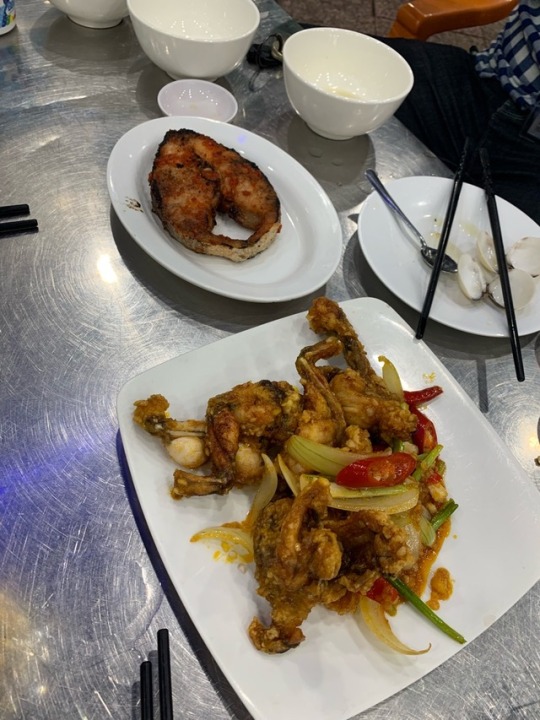

Stop 2 and transit:



Stop 3 and transit/




0 notes
Text
Day 12, Part 2
After stuffing our tummies we’re back on the boat heading to our original port. We see the tallest buildings in Saigon. This is a city city-with sky scrapers and office buildings and new modern buildings. Like in Hanoi there is considerable construction and entire apartment parks that are owned by Vietnam’s richest man Vin. It seems as if he has a mall and large building in every major city. A car dealership too.
At port we meet our driver and enjoy the air conditioning. We would normally opt for a walking tour of some sort but not in this thick heat. Our first stop is the Central Post office which faces Saigon’s Notre Same Cathedral. The church was completed in 1880 and is constructed of all french materials and designed to look a bit like its Parisian namesake. It’s made of red brick from Marseille and is currently undergoing significant renovation. Typically however, it holds 4 Sunday masses including one in English. The post office is a remnant if french colonialism and was designed by Gustavo Eiffel (yes, that one!). construction began in 1886 and was completed in 1891. It’s still in use today and tourists can be found drafting post cards on the back table. Duong Van Ngo, a professional letter writer who speaks Vietnamese, French and English and has been employed with the post office since 1946 is also still there. A giant portrait of Ho Chi Minh is featured on the back wall. From outside the post office you can also see an old grey building which housed the US CIA and from where the helicopter in a famous a Vietnam War photo flew from.


From here we drive toward the Presidential Palace, now knows as Reunification Palace. A palace existed here when the French occupied the area since 1868 but South Vietnam’s president Ngo Dinh Diem commissioned a new structure be built in the early 60s. It shows. We see the offices and also the living quarters. The first president was ultimately assassinated in 1963 so the main inhabitants of this home was the second president and his family. The dining rooms both have two tables—one long rectangular one for eating western food and one large round one with a lazy Susan, with the correct cutlery for each. Large and real ivory elephant tusks can be found in the International receiving room. At this time there were two VPs-one internal and one for external affairs. The Ambassador room is the grandest with a giant layer ware painting composed of 49 pieces. Evidently it can take three months to finish just one piece with its 17 layers. We finish by seeing the bomb shelter basement complete with rotary phones and radio gear, which kind of reminds me of when we visited Churchill’s situation room in London. The art deco style makes me giggle a lot—you can’t help but think of the swinging 60s and then remembering this was a president’s home. It’s now called Reunification Palace because this was where Communist forces crashed through the gates in 1975 to end the war. Thuy also tells us that the original building didn’t have good Feng Shui and so a fountain was built in front—you almost never have a direct entrance to a building like this—it’s why there are screens in front of the entrances at the other palaces we’ve visited—you shouldn’t be able to see straight through! The “palace” is a nice break from the heat though as a nice breeze wafts through.


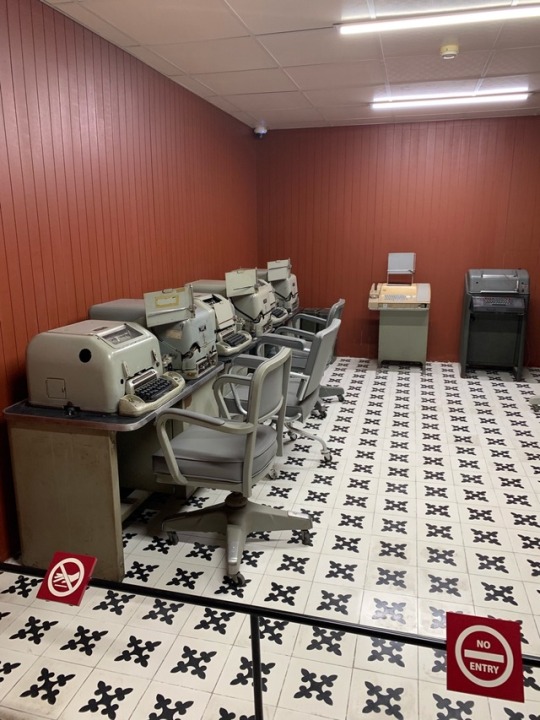
After the palace we make our way to Saigon’s most visited museum, the War Remnants Museum. The museum centers on the atrocities of the Vietnam America war and can be difficult at times to wander through. Inside you can see all the American guns, ammo and bombs used and more bombs as well as aircraft carriers and tanks are situated outside. Inside there are exhibits on the imprisonment of the Vietnamese by both the French and Americans. There is an exhibition on resistance from other nations, and there are endless photographs from the many photojournalists risking their lives to depict the war. The most difficult sections are about Agent Orange and it’s multi generational effect on those exposed. There is a section of artwork done by children on this topic I felt particularly moving. There is a lot to learn about the atrocities of what we did in Vietnam and how we did it, and a lot of disbelief that we did such inhumane things. The perspective of the museum is rather one sided as most exhibitions are here (like the Hanoi Hilton) but for me, this fact didn’t take away my unease on what the Americans did during this war.



After this museum and Kerran gawking at planes and tanks like a school boy, we have a little time to freshen up at our historic hotel which has been in business since 1925. At 6pm we meet our guide for the evening from Vespa Rouge, our two drivers and a pair of vintage vespas—green for Kerran and baby pink for me.
Our first stop is around the corner from the hotel on a bridge just near where we got the speed boat earlier that day. We start the tour with a pair of welcome cocktails that have chilli, Ginger, and lemongrass and are super tasty. From the bridge you can see then unfinished construction of the Saigon subway and one of the cities tallest towers complete with a helipad.

After our drink we hop on the back of our scooters (after our driver crowns us with the helmet—that’s literally what it feels like) and we go for a drive. First, despite the traffic this is not nearly as scary as one would imagine. The tour takes a scenic route around the city and through a local market which I really liked—seeing everyone in their natural habitat, no tourists etc. We stop on at an outdoor cafe in District 4 and make our way to a low table with plastic chairs. We both get Saigon Special beers and our guide orders us two types of clams—little ones and big ones with peanuts. We had a piece of black fish that was likely caught that day, and fried frog legs which taste just like chicken! This is clearly an off the beaten path local eatery and the food is goods. As we are wrapping up a street performer emerged in a midriff baring low neck shirt and jeans (a rarity for relatively conservative Vietnam) and she’s dancing in the middle of the street. This progresses to dancing with and swallowing fire. Again, not a tourist area!

We get back on our chariot-Vespas and take another scenic drive. Our next stop is in Distrixt 5, China town which is evident from the red paper lanterns hanging outside. This restaurant is full with locals and their families. Here we have another type of Saigon beer (some locals drink it with ice!). We eat chicken salad with banana flower, and a massive bigger-than-the-plate Vietnamese pancake stuffed with pork. Instead of rice paper you just roll this one up with giant lettuce and dip it the fish sauce. I am so full but it’s really tasty!
We hop on the vespas again to head toward our third destination. We drive on the highway and I spot a church with Buddhist style influence and LED colored halos on Jesus. We ride through a vibrant street of flower store after flower store. The alleys of Saigon are clearly where the magic happens.
Our last stop is a more upscale affair called Cafe Soi Da. It has a mini garden in it and a nice ambiance.There are couples with arms around one another. Kerran gets a really good pina-colada and I get an equally yummy ginger tea. We listen to a Cellist, Pianist, and Violinist play jazz music and three separate singers accompany them. Most of the singing is in Vietnamese, but one woman sings in french.
After this we board the bikes for the last time and they drop us back off at the Majestic Hotel. We snap a few pics before heading inside and packing our belongings before an early checkout tomorrow.
(More food pics in next post!)
0 notes
Text
Day 12, April 18, 2019: Cu Chi Tunnels, Saigon & Vespa Food Tour PART 1
We get up in our nicely air conditioning room and head from the sixth to the eighth floor where breakfast is served. At the Majestic Hotel, due to construction, you eat on the rooftop which affords us picturesque views of the Saigon River. Passion fruit and a selection of cheese makes this girl happy. Cheese is a limited commodity here because there aren’t really dairy cows. Butter is imported in those horrible individual packets from New Zealand. There are some dairy cows imported from New Zealand tentativeness Residence in the north though.

It’s before 8am and we can feel the famous heat of the Southern region. Last week temperatures hit 41C and we are lucky that today is almost ten degrees cooler.
At 8:00 we meet Thuy, our guide and board a small speed boat with Fish Eye Tours. This is the kind of boat you’d take water skiing perhaps. We head about an hour north on the river toward the famous Cu Chi Tunnels.
The river is a murky brown and there are water hyacinths everywhere. However, evidently, in late seasons, the water has even more hyacinths making it practically impossible to navigate the waters by boat. Our engine gets caught in the plants, as well as the unfortunate plastic bags, on a few occasions. Large boats are also everywhere and sun tanned men man these ships drudging sand from the bottom of the river to turn into cement. It’s crazy how low some of these boats sit in the water!
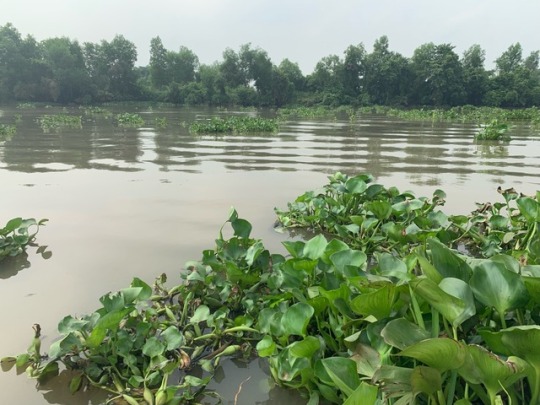
On the way to Cu Chi, over the noise of the boat engine, our guide Thuy, tells me her story. I calculate that she’s in her mid thirties. She has two surviving siblings—a brother and a sister. Both siblings are married to those in or connected to the Communist Party. When she was 16 another of her brothers died in a road accident. Her parents have passed. She is married to a Catholic man who is one of 9. He doesn’t seem very pro-communist. He sells medical devices, which Thuy explains does not have the same kind of “excellent job” status that it has in the US. Thuy is also the mother of three daughters, aged 7, 4 and 2. She had the first when she was 29, but was married at 24.
She asks us if we have any dietary restrictions and we explain that Kerran doesn’t eat crustaceans. She asks if it’s dislike, allergies or “like in Judaism where you can’t eat certain things.” This is a super unique response—most people don’t know much about Judaism here or have met many Jews. Thuy is the exception. She’s surprised and excited to hear we’re Jewish. How does she know so much? Thuy’s second daughter has a very rare condition that affects no more than 175 people around the globe. A friend of Thuy’s who resides in NJ and is a doctor helped connect Thuy to a hospital in St Louis Missouri who provides free treatment (including multiple surgeries) for her daughter. While treatment is free, room, board and flights are not. This NJ friend connected with a local synagogue asking if they would be willing to take in a Vietnamese woman and her daughter while she was undergoing medical treatment. Five families offered to host her. It’s the kind of story that makes you remember that there is truly good in the world. She stayed with a family for four months who kept kosher. It’s also a testament to Thuy and her ability to forge friendships, and also explains her excellent English.
We finally arrive at the famed Cu Chi Tunnels and are enveloped by the loudest Cicadas we’ve heard yet. While the tunnels are famous for their use during the Vietnamese American war, the reality is that they were begun much earlier in the 1940s during the Vietnamese resistance to the French. Back then approximately 48km of Tunnels existed. By the end of the American war however, the tunnels totaled a distance of 250km.

In the beginning of the American war, the tunnels were mostly for bomb shelters and storing weapons. The majority of the locals supported the North. Over time these tunnels grew and 2000 people could be underground carrying out every day life like school and childbirth. In reality more could have fit, but there was only air for 2000z The tunnels were strategically located halfway between Saigon (approx 60km) and the Cambodia (approx 50km) boarder and Ho Chi Minh Trail. Weapons to arm the Northern army and guerilla fighters passed through Cu Chi to Saigon. They often hid weapons under vegetables etc to disguise them in transit.
The visit to the tunnels begins with a pretty strong anti-American film that glorifies life in the tunnels even when we know the conditions were harsh. It mentions a lot of war heroes as “American Killers”
The tunnels themselves have three layers, and the deeper layers were constructed during the American war mostly. The first layer is about 3m deep. The second is 4-6meters deep and the deepest layer is 8-10 meters underground. The width of the tunnels vary depending on use, and today the tunnels you can go in are actually enlarged (and they are honestly not that big!) all of the tunnels were dug by bamboo sticks and baskets. They did this at night and moved the dirt to the river or the rice fields. Within the network of tunnels are meeting rooms, artillery storage, bedrooms, schools, air vents camouflaged as termite mounds, and even a well. There is a kitchen they used only in the early morning so the smoke would blend in with the mist. The vents came out through bamboo forests. There are secret entrances and trap doors and most of the ways in are tiny holes that the lithe Vietnamese could fit in but the larger Americans could not. At one point the Americans even built a base on top of Cu Chi. It took them some time, and the assistance of German shepherds, to even learn they were here.
There are some mannequins all over the place and we can see the green uniforms that belong to the NVA and the identical but black uniforms belonging to the Viet Cong guerrillas. The northern troops used green to camouflage during the day and the VC wore black to better hide at night. The VC also included women. There is an US M41 tank destroyed by a land mine in 1970. This was a heavily bombed area and there are numerous bomb craters to show it. After the war they found an average of 3kg of bomb covering every square meter. The VC used the remains of American bombs and weapons to construct their own. They created numerous types of painful looking traps that a staff member demos for you. It’s easy to see how the local people used their knowledge of this place to defeat the Americans.
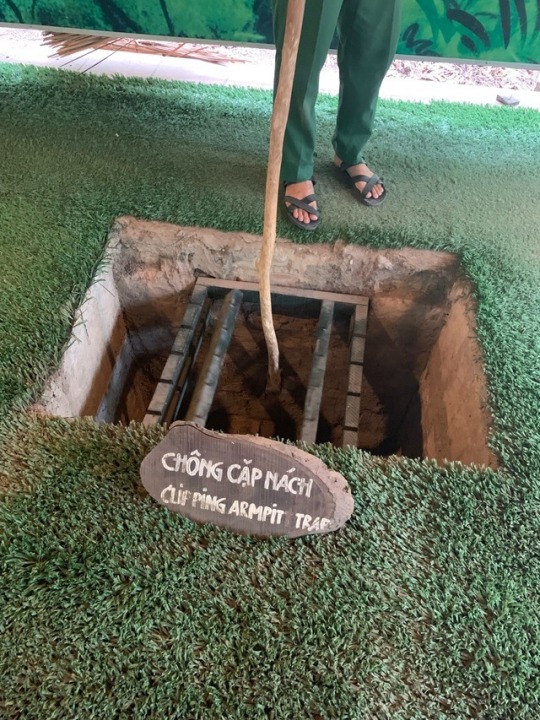
There is a really touristy shooting range near the tunnels which is also super loud. Kerran decides he does want to try the gun with the largest ammo available, the M30. AK47s were the most popular at the time though. I pass on this as it just seems like a creepy place to shoot a gun.
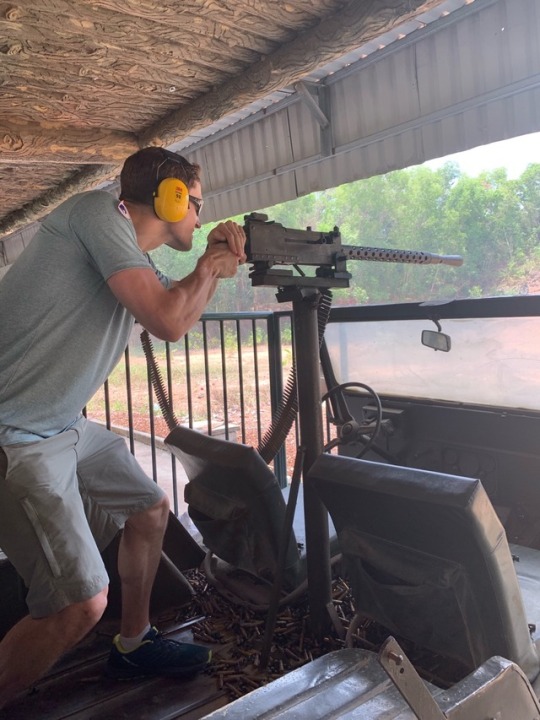
We walk on and go inside the tunnels which as I mentioned have been slightly enlarged. I don’t love small spaces so I obviously can’t believe people lived like this! We also get to see the shoes the VC wore—similar to what we saw in Africa, these are sandals made of tires. The difference here is that the VC wore them backward to make footprints appear they were moving in the opposite direction. Everything is so clever.

Nearby the kitchen area there are jugs of tea and tapioca plant for you to try. The plant itself tastes potato like, but a little more delicious when you dip it in crushed salt and peanut. This is one of the things they ate in the tunnels. The tea is made with the Pandan leaf.
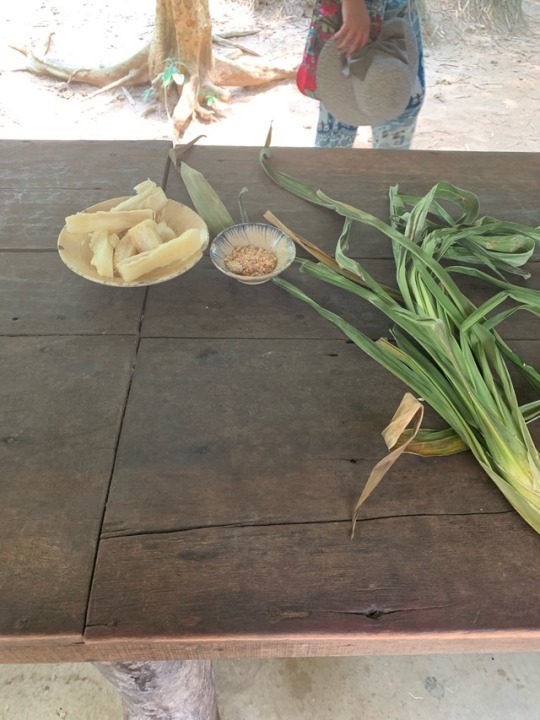
After we wrap up our sweaty visit to the tunnels we get back on the speed boat. We didn’t realize before, but the water hyacinths float, and more are coming together everywhere we turn. On our way to lunch we snack on some Rambutan fruit which is a member of the lychee family, as well as a little dragon fruit which evidently is good for your skin. I love that everyone here espouses the health benefits of whatever fruit your consuming. I can use it because all this sweat and sunscreen is making me break out!
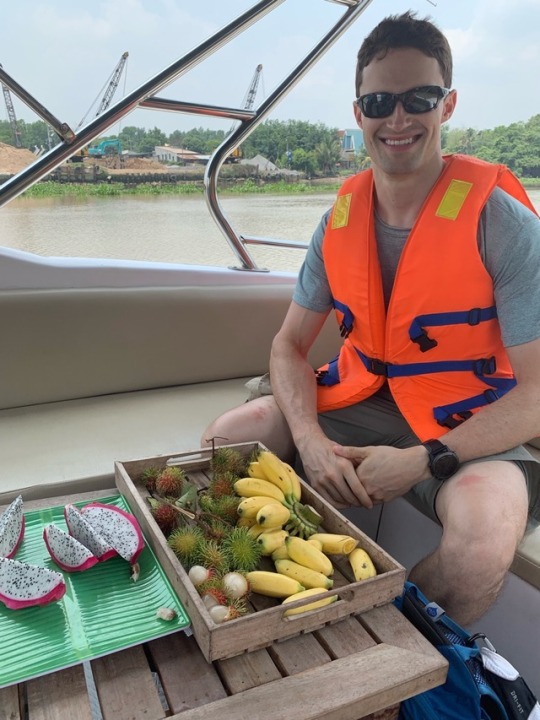
The majority of the dredging and fishing boats here in Vietnam have eyes. This is because a long time ago when the area still was home to animals like tigers and crocodiles, the people believed that painting eyes on the boats would make the animals believe they were an even bigger scarier animal. Today, it’s important that boats can “see” and the eyes bring them good luck.
We stop for lunch along the river at what Thuy tells us is probably the largest restaurant in Saigon. It’s also a popular destination for wedding photos. In Vietnam, wedding photos are taken as far as two months before the wedding. The package even includes a dress (and probably makeup!) The photos are displayed at the actual wedding itself (where you wear a different, rented dress!). The place is beautifully picturesque and it’s easy to forget you’re anywhere near a city at all. The amount of food brought to us however is overwhelming. There are spring rolls, rice, hot pot (which is way too hot). There is chicken satay, and steamed veggies and my favorite: pork in clay pot with caramel sauce which is kind of like a sparerib. As always, there is customary tea served with all this.
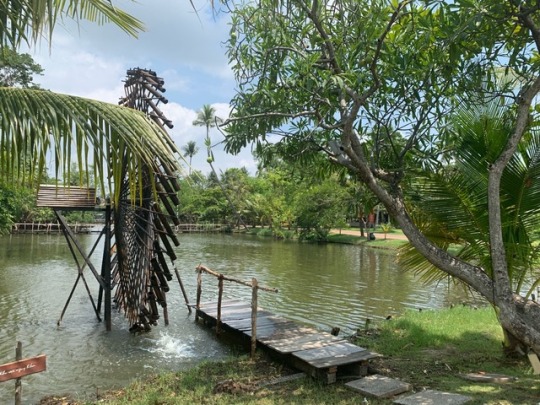
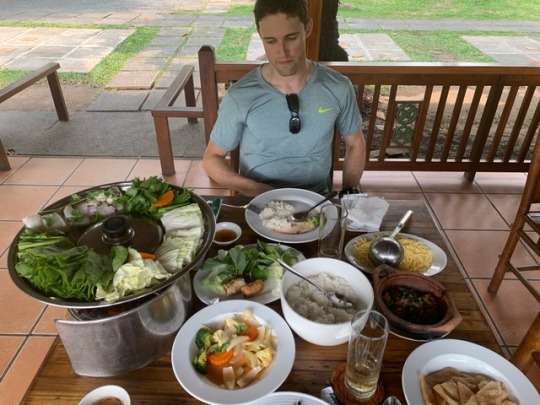
0 notes
Text
Day 11, Part 2
On our way down there are also people burning patches of steep hill for farmings. It’s a difficult place to build a farm but these folks have limited choices and they need this to make a living.
Toward the end of the ride, at the bottom of the downhill the air is thicker with humidity. We pedal through a town that’s far less advanced than any other we’ve driven through and at the end we celebrate our 80km or 50mile ride with a beer and a refreshing wet towel. Kerran also has some sugar cane juice. The woman proprietor of this stop tells me I have beautiful skin. I find this a tad hilarious as I’m sunburnt, sweating, and just all around gross, but I’ll take it.

Seeing a country like this is unbelievable. I know we have to do a bike trip. This is not so touristy. It’s people living. Without flashy lights or (too many) English signs. Roadside cafes have no English menu or English speakers.
After our celebratory drink and a much needed cold wet towel, we get back in the car and the mountains continue to surround us, as do farms. It’s so green here.


At this point it’s about 330pm and we get back in the car and drive toward Nha Trang. The views continue to impress me, there are farms and mountains at every turn. On the way we stop at a tiny roadside hotel, the Allure, just to take a shower. It. Feels. So. Good.
Then we go just down the road and eat right on the “highway.” Trang and Mr. Happy tell us this is probably the only time they’ve seen tourists eat like locals. He says we’re pretty east. Me—this is THE experience. We get pork and vegetables and rice and soup and eat it all right up. We eat on low plastic chairs and enjoy our dinner together. At 6 we get back in the car for the final time and head to the Nha Trang airport.

As we get closer you see the customary construction that comes with up and coming beach cities made popular by Russian and Chinese tourists especially. These are big multi floor hotels on the beach and more and more are being built. Trang admits he hasn’t dropped a guest off at this airport in two years, which doesn’t surprise us when they accidentally drop of us off at the (stunning) international terminal. We bid farewell and I get my first hug from a guide. He’s definitely been our favorite!
This terminal is beautiful and clearly new. It caters to those coming to Nha Trang for the beach. It’s the only place I’ve seen in the country with Russian and Chinese signage in addition to English. We walk to the older domestic terminal which luckily has a much much shorter line and excellent air conditioning.
Security is super fast here and we have time to kill before the flight. I use the time to write these blogs and finally be caught up on the entries! Kerran finds himself a fresh coconut. The most adorable pair of Japanese sisters are behind us. At around 8:20 we board our flight. The lovely lady at the check in desk has managed to get us the exit row. We’re ready for our last domestic flight of the trip and our final leg—to south Vietnam: Saigon and the Mekong Delta. The only thing I’m dreading? The heat.


In Saigon or Ho Chi Minh City we meet our cheerful guide Thuy, a mother of three with lots of energy. She drops us at the Majestic hotel, another beautiful historic property near the Opera House, this time with working AC! We are exhausted and fall asleep almost immediately.
0 notes
Text
Day 11 April 17 Dalat to Nha Trang Bike Day Part 1
Today is the day we’ve been looking forward to. After my last breakfast that includes cheesecake, we finish packing up al our stuff, put on our (washed) bike clothes and meet Trang in the lobby at 8am. A funny thing they do here when you check out in central Vietnam—when you return your key they have someone check your room. They say it’s to make sure you haven’t forgotten anything but it’s mostly to ensure you didn’t buy anything from the mini bar.
Because we didn’t site see at all while we were here, Trang takes us to two key area monuments before we begin our ride. The first is the Truc Lam Temple. Truc Lam means bamboo and this temple is currently home to 120 nuns and monks. It’s much more modern than any other temple we’ve seen, which makes sense given it was built between 1991 and 1993. Famous architects from Hue came to help design and build this beautiful spot which is simple but elegant. The temple itself (which you cannot photograph) is made of dark wood and houses a beautiful golden Buddha. About 3/4 of the way up the dark wood paneled wall is a gold frieze about a meter or so in diameter. Impressive wooden carvings are above these. There is a large bell that was once used for ringing but isn’t any longer. Evidently Russian tourists sometimes attempt to ring in, and so, a sign instructing them not to do so appears beside the bell. It’s interesting to me that the sign is only in Russian and no other language.We meander around the grounds for a little and admire the absolutely stunning flowers. A standout is the Philippines Jade vine and the trees that are netted together—it takes 8! Trang tells us that all temples have water nearby be it man made or natural, and this temple is no exception. It’s made in the yin/yang style and the temple sits between the mountains and the water, or heaven and earth. We also learn that In general temples are funded by donations, and about 30% is supplemented by the government.



Next we jump in our van (our driver today goes by Mr.Happy, likely due to the baseball cap he wears or potentially he wears the cap for the name...) and drive closer to town to visit the Hang Nha Crazy House.
On the way we pass these big modern houses and tons being constructed. It’s hard to photograph from the road but I tried! They are bright colors with dark or honey colored wood around the windows and doors and very pretty, also so unlike the smaller less elegant homes we saw in the middle and north of the country.

The crazy house is settled amongst them but sticks out incredibly. It’s more a kin to a fun house at an amusement park. The architect is the daughter of Vietnam’s third president, Dr. Dang Viet Nha, who studied in Moscow. The project was mostly build in 1990-1993 but it still seems to be growing. Technically, you can stay overnight here but I’m. It sure you’d want to. There are tourists everywhere from 8:30 to 6. The place is kind of wanna-be Gaudi, our of concrete and it’s honestly kind of ugly but also kind of fun.


After this, we get back on Mr. Happy’s van for about 20 minutes. I find Da Lat to be prettiest from above, where red iron roofs dot the landscape. More beautiful houses spring up and surround you and Kerran even attests that one or two look as if they belong in Margate. We pass a giant cemetery and then more green houses and surrounded on both sides by lush green. We reach a giant traffic circle that either is, or looks like the one we went by yesterday and unload our bikes. Here begins 50km of rolling hills through the magical landscape. These aren’t small hills—they are sometimes kilometers long and each downhill, which are never as long as the uphills, are well earned. Scores of yellow butterflies dance across the highway as we cycle. We cycle past school children dressed in navy jumpsuits eager to wave and yell “hello” to us as we go by. The country is truly a friendly one. We pass strawberry and coffee farms and farmers growing flowers and vegetables.
Throughout our ride Mr. Happy ensures that our water bottles are full. Around 1145am, we stop for a snack of banana and pineapple and banana bread. Thankfully it’s much cooler here—-there’s a nice breeze and some cloud cover, and I’m not positively drenched in sweat like at the Hai Van pass. We keep riding for a while longer before stopping at a roadside stop for our picnic lunch. This stop is more like a pavilion—open air but with surprisingly clean bathrooms. There are countless tables and the traditional plastic chairs. I munch on a baguette of herbs, tomato, cucumber and tuna. There is delicious mango to accompany the meal. After lunch we bike another 10km—most of which is uphill, with a significant 2k steep at the end.

If you’re reading this blog you probably know Kerran or I enough to know that we’re absurdly competitive individuals. As you might imagine, doing three super adventury things like rappelling and mountain biking is frustrating for me because Kerran is way better. I know I shouldn’t compare, especially as Kerran actually rock climbs and has spent considerably more time on a bike than me, but I do. So, on the final climb of the day when I tear past our guide and Kerran I feel rectified. Uphills on road bikes are my one and only space (besides skiing). My victory of sorts (thought it’s not a competition!) My pride is short lived though because downhills are not my thing. I’m not yet comfortable enough on a bike to not ride the break and after 50km of mostly going up (around 850 meters) we are about to embark on 30km of basically uninterrupted downhill, a descent of about 2100 meters. There are signs for cars informing them of the danger ahead—use a low gear.
In addition to this gift of a downhill is an hour of uninterrupted epic views. After every s-curve is an unreal view that neither a photo nor video could possibly do justice. After every turn is either a waterfall or hilly views of green and brown. It’s stunning. I’ve been to many a gorgeous look out point but what makes this so special is that it’s continuous—happening over and over and over again at countless angles. Plus, it’s not covered in tourists. It’s serene. It’s every reason you go on a bike trip. It’s validation for starting to cycle. Kerran even says “I’m so glad you started biking.” We have my mother to thank for that, for this.



This is Vietnam. Epic and green and gorgeous. Unencumbered. Stunning.
0 notes
Text
Day 10, April 16, 2019: Mountain Biking in Da Lat
Our guide Frankie (aka Thang) was bummed to hear that rappelling did not tire us out so he decides to swap his plan for an easy course for a harder one today. I’m under the impression we’re setting out for a trail bike. I am wrong.
Today we meet Thang at the Pine Track Adventure office which is about 15 minutes walk from the hotel. He’s ready for us with two bikes and we hop on ready to go. We start our day with a 7km bike outside of Da Lat. it’s fun to be part of the traffic instead of dodging it skillfully as a pedestrian. Crossing the street in Vietnam is genuine challenge—and that’s coming from someone who prides themselves on their j-walking abilities.
The ride out is past homes that are far bigger than those you see in other cities and in a European style I’ll speak more on later. Eventually we turn off the paved road and onto packed dirt. The start of the ride here is easy enough and rides past countless farms. Here the farms are green houses covered in plastic tarp they replace every five years. Da Lat grows more interesting crops than the majority of Vietnam—three types of strawberries, flowers, coffee, even avocado.

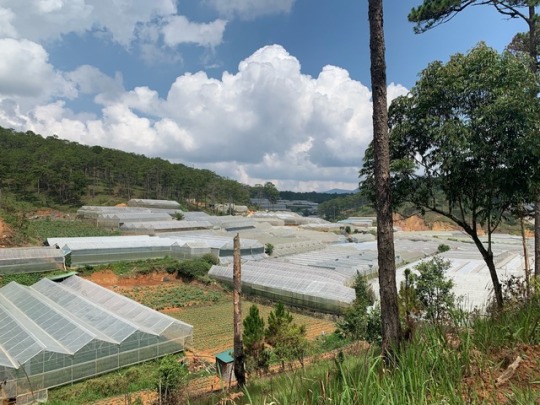
Eventually we ride into the woods for 18km if genuine up and downhill mountain biking. While Kerran has done some downhill mountain biking neither of us have done this before and it’s technical. As a reminder I’ve spent less than a year riding and my technical riding skills are sub par. We go up and down some hills and I’m feeling pretty awesome until we get to an uphill with deep ruts. Yeah, not getting up this—the steep is fine, the grooves are hard! I walk my bike. This happens on a number of hills and I feel a little better when Kerran also gets stuck and has to walk or jump back on the bike. We also find a single track area which is super narrow. I do okay for a while but get off when I think I’ll fall down the whole mountain. Kerran makes it most of the way down a tough downhill though. Eventually the super challenging part ends and we continue riding up a long uphill. Riding on this terrain is way harder than a road bike but at least I’m now walking the bike—I swear it’s more exhausting. Toward the end of our ride another group of bikers catches up with us (in our defense they have actually mountain bikes many a time before today) and we ride back toward the city. In true Da Lat fashion, it begins to rain. A lot.


We all pull over at a nearby cafe. At all coffee shops here they serve free green tea. Kerran gets both an avacado smoothie and a beer. Thang gets coffee. I get a ridiculously delicious peach tea. I think it’s here where Thang tells us about his family and how he grew up about 200km from here on a coffee farm. His brother lives closer to home and takes care of his parents and therefor it’s him who wk inherit the coffee farm. (Apologies if I’m repeating myself..I can’t remember if I wrote this part already...)Thang originally studied law but the mountains were calling and he’s been back in Da Lat for many years with his family. He tells us that at age 50, or whenever he can no longer work outside, he wants to open a coffee shop that also really educate people about where the coffee is from and how to drink it etc.

When the rain slows down a bit we get back on our bikes and ride back to town. Of course it starts raining again but we decide to ride on back to the Pine Track Adventure office. We do a total of about 30 or 33km today.
For lunch we borrow and umbrella from the office and walk down an alley with Trang who takes us to a small local restaurant, one without English menus or English speaking staff. We eat pork and rice and unlike yesterday, I pretty much devour it all.
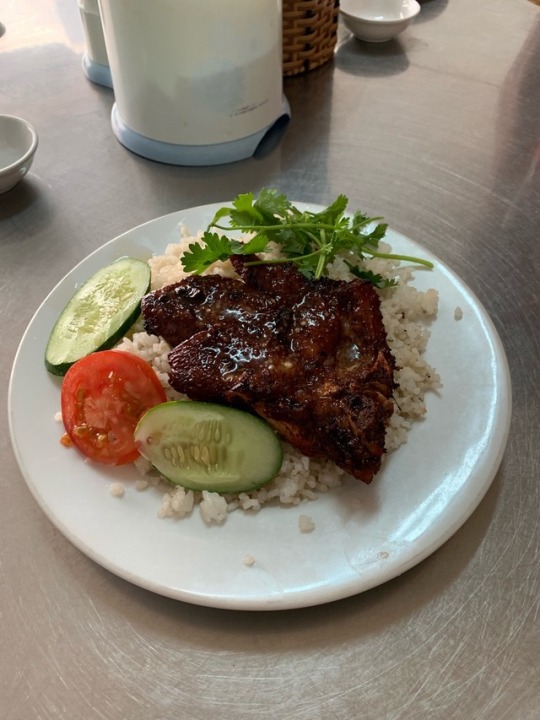

Our original plan was to do some site seeing today but the rain is getting in the way. It’s cleared up so Kerran and I decide to take a longer walk home. Terrible idea. It begins torrential down pouring and yet we continue walking. We walk past many people huddled under overhangs, as well as people draped in ponchos on the back of their motorbikes. A nearby stairwell looks like an actual waterfall and the roads are covered in tons of water. When we arrive back at our hotel it looks like we’ve gone swimming.

After hot showers we decide that the rain isn’t worth venturing out in and we do something we never do—nothing. We do some research and find out how to watch Game Of Thrones Season 8 Episode 1. It was a solid choice. The rain wouldn’t lend itself to visiting the sites anyway.
We do however make it out of the hotel for dinner. We walk past the Pine Track office to Artists Alley which is very much down an alley and also very much covered in art. It’s quiet there except for maybe two or three other couples and a local guitar player. Kerran orders Chicken with Ginger and I get Beef with Ginger. It’s good, but not as good as our first dinner at Trong Dong. Dessert is not really a thing here but they always have some sort of banana thing. This was just banana and chocolate sauce and it was rather unimpressive.


We walk back from the hotel but the short way—we learned our lesson! We walk back through the night market which is significantly quieter during the week. We pick up some dried fruit, blackberry candies and fruit candies from L’ang Farm, a local chain selling some of Da Lat’s specialties. When we arrive back at the hotel room, i am spent and I know I need a good night sleep for the day ahead. I pack as much as I can and set the alarm for 6:15am so I can finish the rest in the morning!
0 notes
Text
Day 9, April 15, 2019: Canyoneering in Da Lat
After a mediocre sleep due to lackluster air conditioning Kerran and I wake before our alarm. We’re sad to get a text from Kerran’s father (and then a phone call) informing us of the passing of Kerran’s grandmom Mary, a most impressive 95 year old who was whip smart, talented and so kind. She lived a full life with 9 children, amazing grandchildren and 4 great grandchildren. The funeral will be Wednesday, and unfortunately we won’t be able to be with the Flanagan family to celebrate Mary’s impressive life. My heart goes out to the whole family and I’m so sorry we won’t be able to be there for her funeral. We celebrate her by doing what she did so well—living.
We make our way to another impressive breakfast buffet. This one even had desserts! After breakfast, around 830 our van comes to pick us up and takes us to Datanla falls. There’s an area set up for all the companies that host canyoning trips and we start there getting on our gear and doing a practice rappel. When we’re ready , Frankie and our other guide (whose name unfortunately escapes me) head toward our first obstacle. To do so we must walk down a set of steps past a small roller coaster and a lazy persons cable car. Our first obstacle called water fall 3 has an audience. It’s a more basic repel but it’s slippery! It’s about 16 meters high.The second element is a rappel into a zip line which is always fun! These are definitely more complicated and interesting than the canyoning we did in the Azores. The next thing we do is more like a slide. One of the slides we do head first and one we do feet first. In some ways this is the one that scares me the most—no rope (of course a life jacket) and going head first is always a bit freaky! Between the obstacles are some mini hikes or a chance to flat down the river. After this come the three hardest elements. The first is a 21 meter rappel with a 4m jump. This is a big waterfall where you rappel right down the middle in just your socks. Toward the end the rock becomes concave and you must release the rope and jump. For some reason this one doesn’t scare me too much and I really enjoy it. The next one is a free jump which is totally not my thing so I skip it but Kerran does a jump at both 7 and 9 meters. The last element is definitely the scariest and it’s called the washing machine. You rappel until the rock is concave and than you release your legs. You then lower yourself into a fishing fall and at the end you kind of spin around and have to let go of the rope. It’s totally freaky but I feel accomplished when we’re done! After this we hike out of the area which takes about 25 minutes.

After the long waterfall with jump!

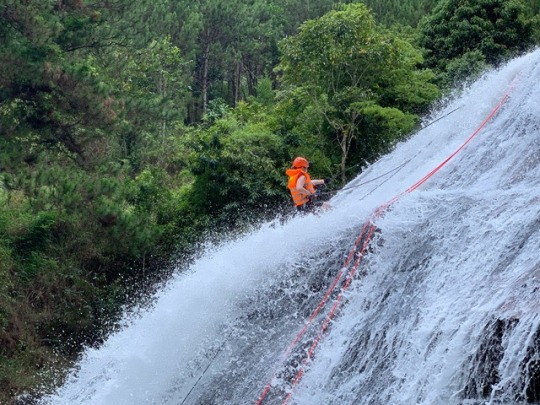
First Rappel (Kerran) and Big Waterfall with jump (Lauren)

(Washing Machine)
After lunch we climb back in the car and are dropped off at our hotel to rinse our drenched clothes. Kerran is currently training for a Spartan Super so we avoid the rain by doing arm and abs workouts in the gym. Late afternoon Frankie drops off our laundry which was done for the same price it would cost us to do one shirt at this hotel. After that Kerran and I put in some running clothes. We lap Xuan Huong Lake which is about 3 miles, and add a fourth by running past the radio tower which is shaped just like the Eiffel Tower. I decide that it will be comical to do this run dressed like the pink power ranger.

I love running a city because you see things differently. We run past beautiful parks with dragon shaped topiaries. We also run by bourse and buggies with unfathomly (made this word up?) small horses. Hardly anyone is running besides us. We pass by a big building shaped like a sunflower which we later learn is just a coffee shop! Da Lat is well known for its coffee growing.

After this we’re understandably tired and decide to avoid the rain and the crowds and eat locally at the hotel. The restaurant is beautiful, but definitely not the tastiest fare we’ve had on the trip. The service is excellent but it’s also the first time we struggle to communicate. Google translate proves useful as we order food and drink.
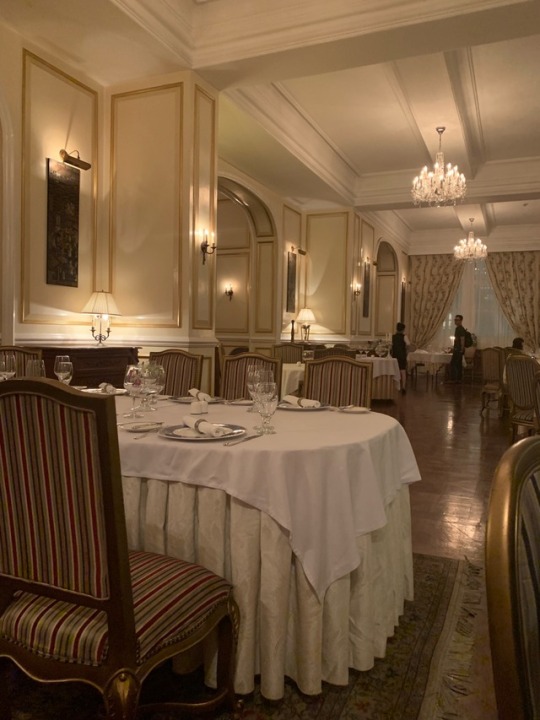

By ten we’re in bed and totally exhausted!!
0 notes
Text
Day 8, April 14, 2019: Hoi An Eco Tour and Da Lat
Unfortunately due to some flight changes on the part of Vietnam air, our original plan of a late flight to Da Lat was moved up to the afternoon. While this decreases our time in Hoi An, it did not prevent us from completing the Hoi An area Eco Tour, a piece of the Vietnam trip my grandmother really enjoyed when she visited last year.
Our tour guide from Jack Tran Tours was Viet and he greeted us with a smile and sense of humor bright and early at 7am. He took us on a short van ride to our beach cruiser bikes for the day. We hopped on and peddled out of the main city past rice paddies and new highways. Our first stop on the tour was a home belonging to three women in their early 60s: 61, 62. 63. One was widowed young when her husband died of a moto incident at 24. Another had a son. This is likely the one who also has a grandson who just turned one. Birthday decorations remain outside from the previous evening.The last woman never married. The three live together in a very basic home. They sleep on what westerners would call a rather antiquated bed, without a proper mattress. In addition to getting paid for hosting tourists like us, these woman make money by farming and selling their crops at the local market.They wake up at 2am to begin to water their crops, which they do by hand except for when it’s really really hot. These women have about 700 square meters and they grow mustard seeds (which take a week) as well as onions. Morning glory, lemon basil and more. Many of these plants require growing and then transplanting over to a new part of the farm for replanting. They fertile the soil with seaweed from a nearby fish farm, as well as cow or water buffalo dung. Two of the women are home when we visit. The oldest is 63 but looks far older. She is permanently hunched over—a direct result of her watering the garden which she can no longer do. That doesn’t stop her, she is still hustling about. A younger one is working and watering and urges us to take a try at watering and then planting. She too is slight and looks older than she is. Some of her teeth are missing, but that doesn’t stop her from smiling. Before departing she hands us a bag of fresh herbs and lettuce for our upcoming lunch. Talk about organic growers. 220 families around these parts once grew food for a living. Today, about 130 continue to farm and 90 or so have moved to work in the tourism industry. Farming is not a particularly lucrative trade. Despite being expert exporters of rice, just growing rice is a hard salary to live off. A 49 hectare dawn may yield one crop after three months. These 3 months earn the family less that what they can live on. After all a farm this big might yield 400kg in seed but after shelling, only 280kg of rice. If we assume 1 dollar = 2kg, for three months work and a whole harvest, only $150 might be yielded from this harvest. Most people supplement this farming income with other crops tourism etc. the Mekong delta which we’ll visit later this week is the largest and main exporter of rice in Vietnam. Unlike here they can harvest not two, but three crops of rice per year.
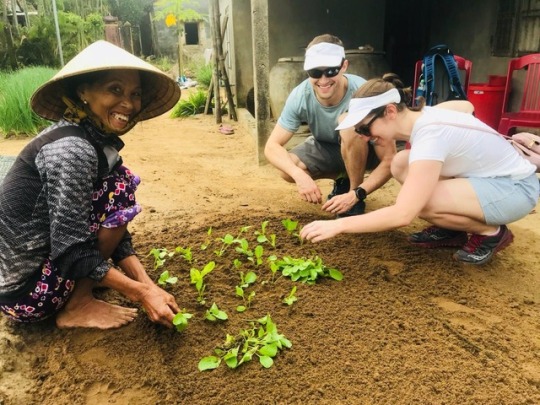
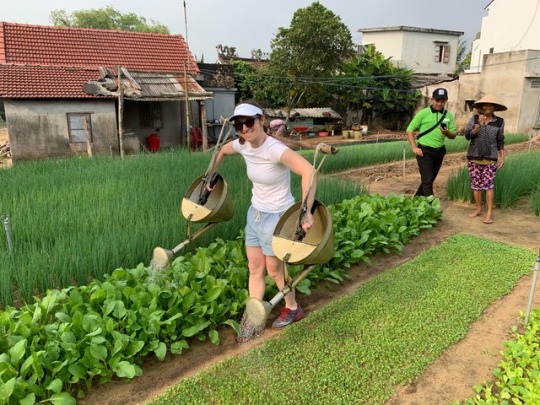
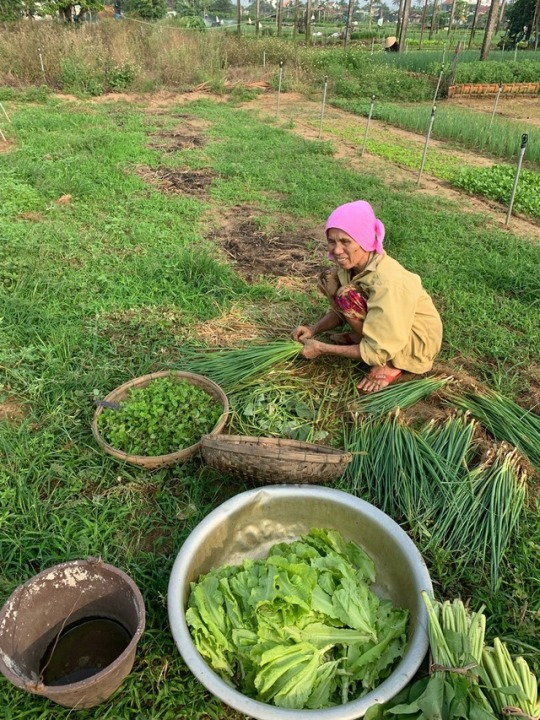
We get back on our bikes and cycle past a number of shrimp farms, and of course more rice paddies. Near to a large traffic circle and the highway we dismount once again for the most touristy part of the trip—water buffalo riding. This is when I learn that the only animal Kerran has ever ridden is a camel! The coolest part about this stop is actually the nearby brown cow (they don’t have black and white ones here) and the day old calf following it around as it learns to walk. After our carnival-like bull riding experience we get back on our bikes and cycle toward the river. We pass the countless beach side hotels and wave hello to the ocean. Like Danang, more resorts are popping up often. Our guide Viet’s wife works part time in one hotel doing laundry, but not for the next six months as she had their first child six days ago!
On the river side, we board a boat and take off our shoes as instructed. We are in Coco River, names for the long necked bird (is egret) that you can see everywhere. Coconut cake and sliced pineapple await us for a morning snack. We begin sailing away from land toward the open bay. Our first stop is a small fishing boat. A jolly woman rows from the back while a man throws a net out repeatedly. The net is beautiful as it’s tossed. We board their boat and see that they’ve just caught one small fish. Kerran tries and does well on his first try. I kind of suck at it. We don’t catch anything but the experience is cool. Admittedly this is pretty late in the AM for this.
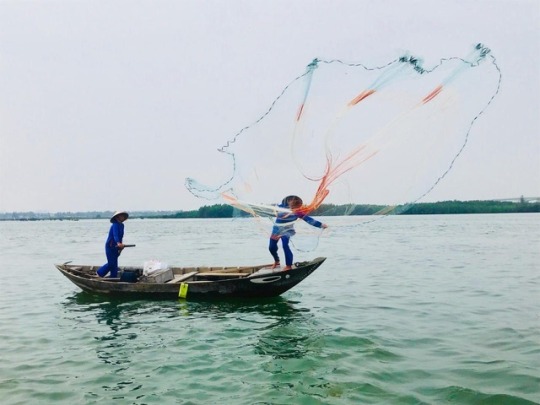

We get back on our bigger boat and sail on. We pass the fishing village of a Cua Dai (another name for the river) where Viet grew up. This is a village with about 5000 people. In 2000 about 90% of people worked in fishing. Today, only 40% work in fishing and the majority of others have moved to tourism. Viet is one of five kids—his brother is in construction but all three sisters work in hotels as chambermaids, doing laundry etc. All of the girls stopped school at age 12 while the boys continued. Today however schooling is compulsory for both genders until age 18. Similar to our first guide, Viet got electricity in 1993. He remembers the whole village circling around the two televisions in 1998 to watch a soccer match. In 1999 UNESCO names Hoi An a historic world heritage site. Tourism has been growing exponentially ever since. In 2017 Hoi An saw and estimated 2.5M tourists. Last year there were 3.8M. There are 150,000 people living in Hoi An! Viet thinks about 70% are from China and Korea, and this is less good as most reside in Chinese owned hotels in nearby Danang.
We sail onward toward the water coconut forests. These plants aren’t endemic to the area and are originally from the Mekong delta and used to help prevent erosion. The coconut forest was also a hiding place for about 140 Vietnamese during the American war. Only about 40 survived, half of which were heavily injured. In this place about 1000 people died, including the Vietnamese soldiers, Americans and locals. In wet season they hid right in the water eating fish and the oysters that dot the palm trunks. In dry season they covered themselves with mud to camouflage themselves from the Americans. Today it’s a beautiful area (well, the parts that aren’t littered with trash). The crew of our own boat demonstrated how to use circular basket boats made of bamboo. They are waterproofed with tar and cow dung. The Vietnamese originally created these (based on a Welsh boat) because the french taxes the length of boats and this significantly decreased the cost. Today they cost about 200-250 US dollars. The staff do a demonstration, cheekily singing Gangnam style as they go. Then we get in and it feels as if we’re on a tilt a whirl. After this bit of touristy and somewhat gimmicky fun, Viet also boards the boat and we sail through the forest. We pick up garbage as we go and eventually reach an area without too much litter. Both Viet and the boat rower start using palm leaves to create some very impressive origami. He also constructs two fishing rods and baits them with an oyster from the palm leaves. We are going fishing for crabs. Kerran lures the crab in with his bait and we scoop the black crabs with purple pinchers into what looks like a leftover gasoline or washing detergent canister. We catch a few but they are all quite small so we ultimately let them go.
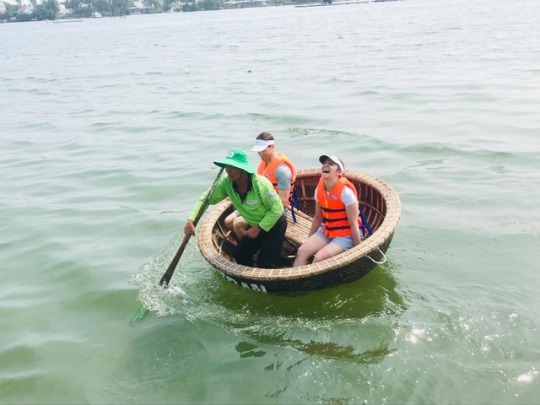
We then board the big boat again and head toward our last stop to try another type of fishing. Nearby the beach we board the small basket boat once again to get to shore. On shore is a large contraption used for reeling in a giant net. Typically these fisherman are out from 5pm to 3am but our host is up and about for us. He’s heavily tanned from being in the sun and has use only of one arm and yet he manages to reel in this heavy thing. The large net has holes in very strategic places and he strategically moves the net to get out the fish. This morning we catch nothing but small babies so we let those go.
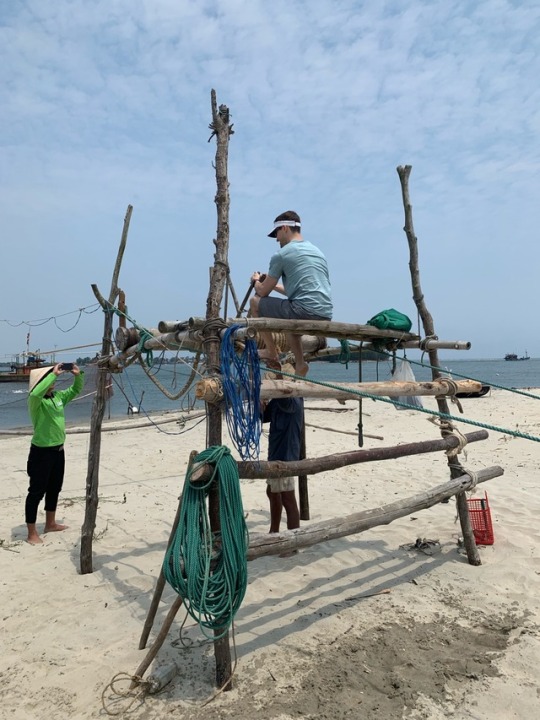
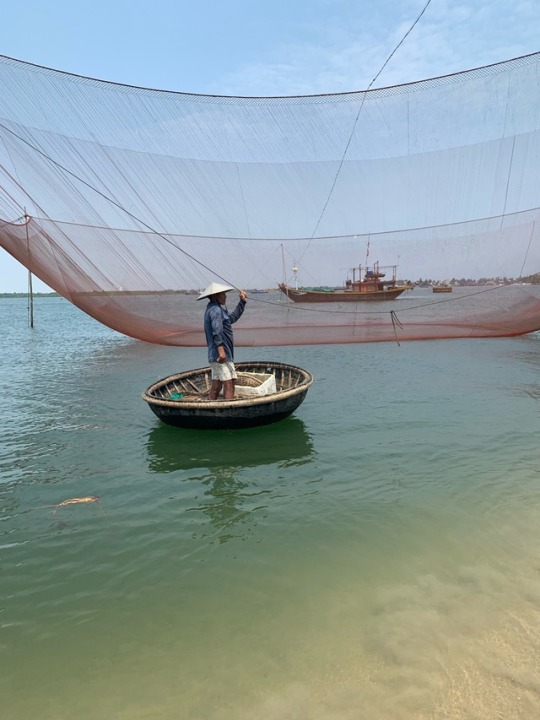
Back on board the bigger boat the crew is making us lunch. As always with these touristy things, there is more food than we can handle. We start with spring rolls, then get a calimari salad, grilled mackerel, tons of rice, traditional morning glory and the pancake spring rolls I had last night. Dessert is mung bean cookies. I am completely stuffed. We sail back to shore and Viet boards a small van with us back to our hotel. The driver could be a NYC cab driver—he’s a bit aggressive and swerved around tour busses. I am genuinely fearful for the motorbikes on the road!
We’re back to the hotel in time to freshen up before Hoai picks us up at 1:25pm to take us to the airport. We bid farewell to Hoai and take the one hour flight to the mountain region of Da Lat.
Boy are we glad when we get here. It’s cool!!! Our guide, who insists we call him Frankie, meets us at the airport. He’s clearly more outdoorsy than the other guides, and much younger, just a few years older than we are. He studied law and English at university but after a year of attempting to practice law in Saigon after university, he was itching to come back and become a guide. He says his mom was not thrilled! He has both a ten year old and 1 year old girl.
We check in at the Dalat Palace Hotel, originally built by the french and finished in 1922. It has all the charms of a historic hotel but admittedly, is in need of a bit of a renovation.
We freshen up and meander into town where a bustling night market takes place. This weekend is also a holiday weekend so Vietnamese tourists are everywhere. The night market here is less touristy and more authentic-people selling warm weather clothes and countless foods. You can easily identify the Vietnamese tourists because they are dressed in hats and scarves. It’s probably about 65 degrees.
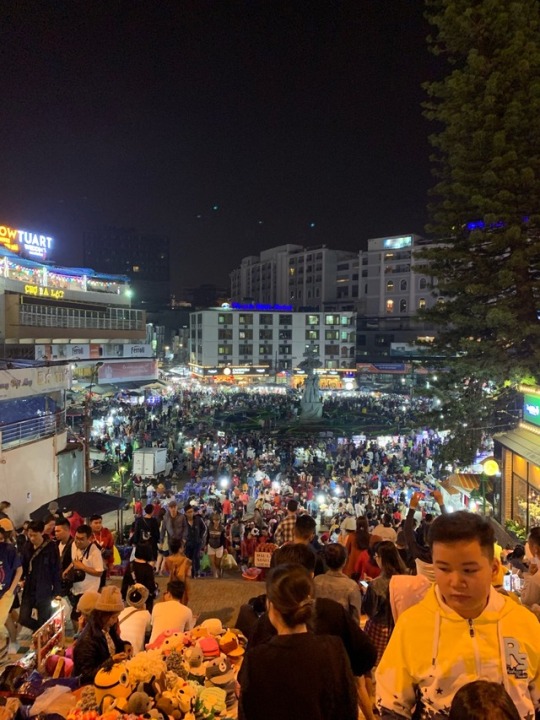
We eat a bit off the main drag at a small restaurant called Trong Dong. When we arrive we’re the only ones there but a few other couples wander in. There are only about 7 or 8 tables here—each covered with a plaid table cloth that is then layered with a white one. It’s quiet and cute with an extensive menu of Vietnamese food. We learn at this dinner that Da Lat produces wine (it’s okay). I get a delicious clay pot of spicy pork.
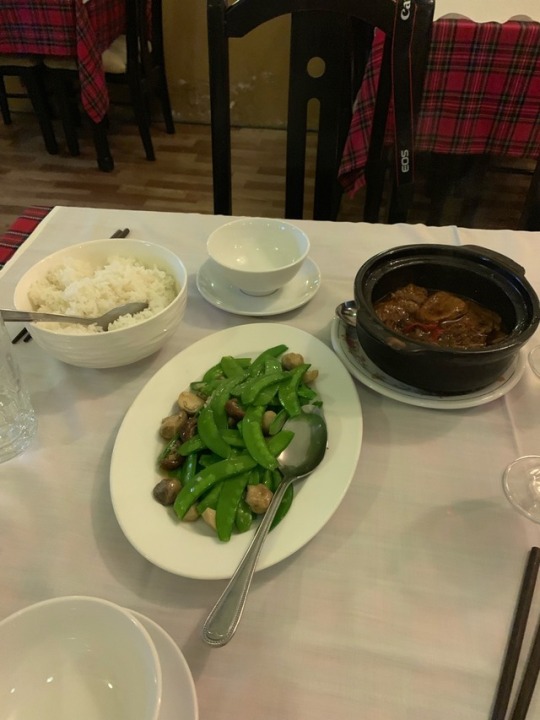
We’re exhausted after dinner and meander our way back through the night market toward tour hotel which is perched on a hill and overlooks the towns lake. We stop to take pictures of an impromptu dance session and the boards of people eating and enjoying the market. This city is funky—it’s both beautifully adorned with flowers (earning it its name of the flower city) and also somewhat kitschy with lights all around. We’re ready to explore!
0 notes
Text
Day 7, April 13 Hoi An and My Son
We wake up early again (Kerran is getting used to it!) and are impressed and surprised to find a comprehensive breakfast spread on the ground floor of our hotel. I tried a Vietnamese pancake, enjoyed the roasted tomatoes everywhere else in the world seems to serve (among other stuff) and Kerran has his typical feast. My arms are a touch sore from the lifting we did two days ago but my legs are fine from the 30miles of riding.
At 8 we met Hoai and a new driver (who was no Huy!) and drove about an hour from Hoi An toward My Son temple, eBay some refer to as Vietnam’s answer to Ankor Wat. This is a Hindu temple complex belonging to the Cham Dynasty. The Cham Dynasty was a powerful matriarchal kingdom that predates the Vietnamese in this area. The temples date from around the 4th century but we’re continuously built upon over time by subsequent rulers. The Cham ultimately were pushed out of Vietnam in the 13th century, well before the French discovered these abandoned temples in 1885.
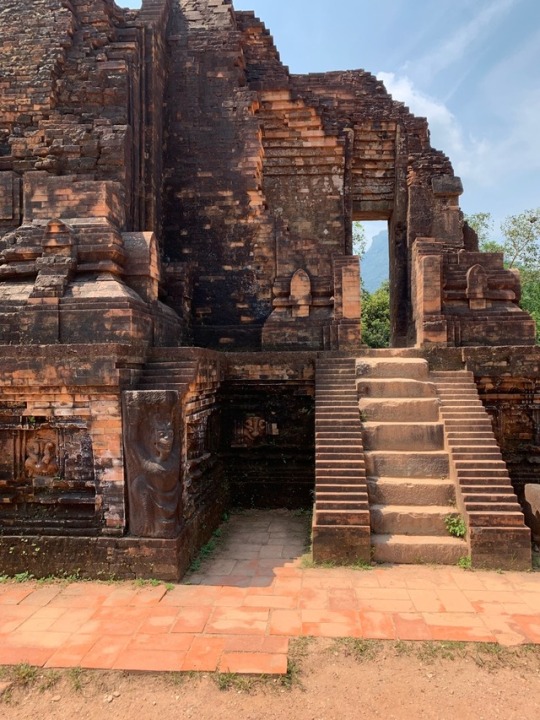
After passing through two reddish brick arch ways you board a golf cart like shuttle (but bigger) further showing how far this is from anything else. A few years back Hoai tells us that you wakes this long path and there was no road. Now, Kerran and I are far from lazy, but with burning sun on our backs we are incredibly grateful for the electric car. Sweat is easy to come by here!
In the early 19th century after the French discovered this space, together the french and Vietnamese studied this place and captured photos. During WWII, the franco-Vietnam war and of course the Vietnam war, fighting and bombs further destroyed the site. Bombs from the American war topped a 28 meter tower. Today there are remnants of nearly 40 buildings at different stages of reconstruction. Where possible they will rebuild building to look as they appeared in the original photos captured by the french. Of course by then much was ruined as well. It’s interesting because you can also walk in these ruins. It’s also interesting that the bricks are held together by a glue made from nearby trees, and these have held for centuries!
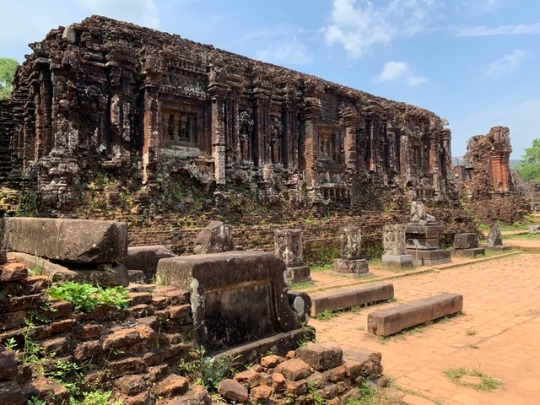

My Son is situated in a beautiful lush mountainous area. The scenery alone is stunning. We choose to skip the traditional dance offered in an outdoor theatre—we’re melting.
We head back toward Hoi An for a day of exploring the old city. Our first stop is back at A Dong Tailors as we promised Huong that we’d be back as early as possible. I try on my dress and we take it in a bit more and Kerran his suit. He’s so pleased that he is moved to order three more casual shirts. It’s so impressive that both our suit and dress were started around 6am and finished at 10am. Huong asks us to come back between 4-5pm for what she hopes will be finishing touches.
Around the corner from the tailor Kerran and Hoai grab a famous Bahn Mi from the “Bahn Mi Queen.” I have a bite and can’t deny that it’s delicious—it has tons and tons of food inside like hm and meat and chili sauce and aioli and vegetables and more items than I can name. We walk through the old quarter and I order ice cream for lunch at the cargo club where we’re permitted to all eat upstairs overlooking the river. It’s so incredibly hot I can’t possibly fathom eating anything else. Across the river where the night market now sits, Hoai tells us that just a few years ago was hardly anything. Rapid growth has occurred due to tourism. However it’s imperative that all buildings in this area are constructed or refurbished in the same style to maintain the historic look and feel of this UNESCO World Heritage site.
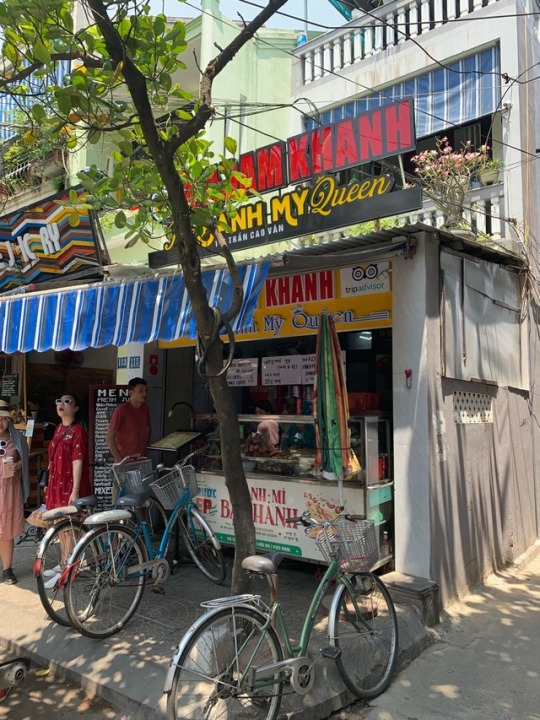
After a quick lunch we head to the sites of Hoi Ann’s old town. Here you purchase a UNESCO ticket that affords you entrance to up to five monuments within the city. We cross the small Japanese covered bridge which dates back to the 17th century and joins the historic Japanese and Chinese sections of the city. Monkey statues guard one entrance and dogs the other. There is a small temple adjoining the bridge which was not built by the Japanese, but later by the Vietnamese. Inside are pictures from the 1700s and later when the french came. The french nicknames this city Fai Foo because those are the Vietnamese words they used to ask “is this the city?”

We then visit our first ancient house. A niece of the man who currently lives here shows us around and informs us that the house was originally constructed in 1780 and has housed 8 generations of her her family. 80 columns hold up this house and sit on top of marble to avoid damage from both humidity and termites. We don’t linger long here as the whole family seems to be selling something. The architecture has influence from Japanese, Chinese and Vietnamese styles.

Later we visit a second home, the Tan Ky home which is about 200 years old. Here you can see how high the river has flooded the homes each year—well above my head. The family moves all its belongings to the second floor during the rainy season through a kind of trap door. You can also see photos of the generations of families who inhabited this home and you walk right through tot he river side.
We also have an opportunity to visit two different Chinese Assembly halls. Each hall is from a different Chinese province and thus reflect slightly different styles. The first is the Cantonese assembly hall, or temple really. The giant dragon sculpture in the middle foyer is the standout here. There is an even large more impressive multi dragon mosaic sculpture in the back!


The second assembly hall belonged to the Fukien or Fukien people. It opens up to a beautiful garden adorned with flowers and even a model of the Great Wall. This temple dates from the late 17th century and was completed in 1757. Three main alters are found inside, the middle of which includes Fujianese mandarins. There is also an alter for the god of prosperity and one for the goddess of fertility surrounded by many midwives. This hall, like the last, features a replica of a merchant boat which honors all those who do not come back from the sea. Hoai also informs us that many Vietnamese share the same last names. Anyone of Chinese descent often has the last name Minh and even has an image of china on their government ID. Hoa’s ancestors are from both Vietnam so his license has an image of Vietnam.

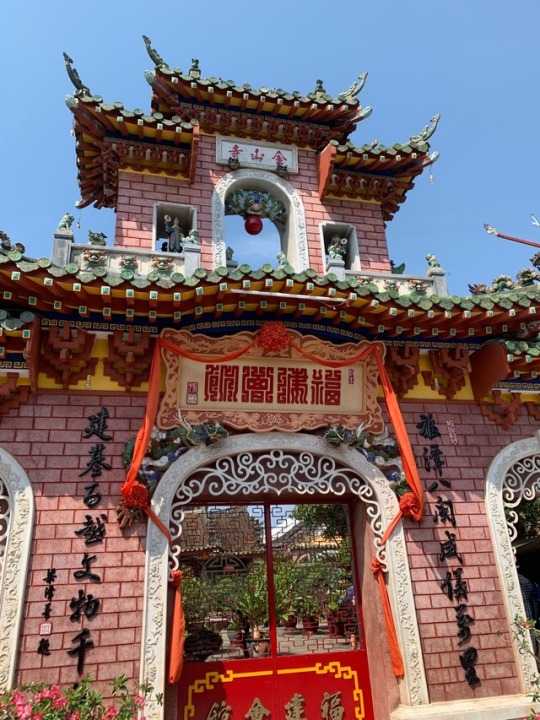
At this point we have used all our tickets and are drenched in sweat from the heat. It’s early afternoon so we make our way back to the hotel and take a short swim in the hotel pool. We honor Huong’s request and are back at the tailor before 5pm for final fittings. We have a few final adjustments to make (bringing Kerran’s shirt out a bit, adding buttons to his suit, and making a last minute change to the hem of my dress.) It’s crazy how fast they do this! 10-15 minutes later the clothes magically reappear perfectly. After bidding farewell to my Hoi An Tailor fairy godmother Huong and A Dong Silk we pick up Kerran’s dress shirts down the road at Be Be Tailor.
After this we head back toward the river for our final Hoi An dinner at Morning Glory. This restaurant is named after the typical vegetable dish served here which is basically just spinach and garlic. The service is pretty bad here but the food is good. I order Banh Xeo which is a hybrid of a pancake and a make your own spring roll. I got the traditional Cao Lao for dinner and Kerran got the (better tasting) mackerel. People sweat by Cao Lao, a meat and noodle dish topped with fresh greens, wontons and spice, but it’s not my favorite of the trio. We end there meal with bananas drenched in coconut cream. We wander a mile or so back to our hotel and stop at the tourist stalls for a needed purchase: Kerran gets a defective Nike shirt for $9 and I replace what I’ve been calling my “beach or travel pants” for 12 bucks. The 15 year old pair was overdue for retirement...plus I stained them with mouth wash on the way here!! After our successful shopping trip we packed up our things and called it a night in Hoi An.
Ps there are also beaches here but we just didn’t manage to get there this time!
0 notes
Text
Day 6 April 12, Hue to Hoi An via Bike and the Hai Van Pass
Today is both a sad and happy day. Sad because we bid farewell to our majestic suite at La Residence, but happy because we have bike shoes on.
After our final breakfast at La Residence we drive a short distance to meet our bikes and the two men from the bike company who will follow us.
Our first ride is a brief one—maybe six miles, toward the Than Boan Bridge, a gift from a former Nguyen Dynasty queen to the townspeople of this village (Than Boan). We see the beautiful bridge of course, but we also amble through the traditional market full mostly of women selling vegetables and fruits from their gardens. This is unlike the touristy markets hawking souvenirs. There are fish heads and meat and much more. Hoai, our guide buys some dragon fruit, mangosteens and oranges for us to munch on later in the day. The majority of our first two rides are around rice paddies. They are mostly flat, but beautiful. We pass duck farms with hundreds of white ducks and adorable ducklings.


We then bike around the bay of Lang Co where the local people use a seemingly endless supply of motorcycle tires to grow and farm barnacles. To our left is a beautiful bay and to our right are the mountains of the area. This is a slightly longer ride and our guide Hoai has taken up the rear and the bike mechanic has led the way. When we reach the highway we stop at a roadside cafe and cut our fruit. Holy smokes is mangosteen delicious! We also try sugar cane juice which is as delicious as you’d think. We’re also pretty drenched in sweat as it’s above 90 degrees with about 90% humidity.

After our sweet and sugary snack were fueled up for the highlight of the day. Hoai jumps back in the car—the uphill ride will be a bit too much for him. We’re headed for the 10km ascent up the famous Hai Van pass that most people yearn to do via motorbike. We’re doing it without engines. This is a 500m climb with multiple sections of 8% inclines. The bike mechanic starts the ascent with us, but quickly hangs back and jumps in the sag van. Lots and lots of cars pass us—including truck loads of dairy cows that have been imported from New Zealand heading the the northern highlands. Motorbikes on both sides of the road beep at us with what one man seems “mad respect.” Were the only bikers on the road, and okay, we feel a bit like mini celebrities. We stop only two or three times to make sure we’re getting enough water—the heat is climbing and the sunscreen I’ve put on has definitely sweat right off. The average temperature for our one hour ride is about 95 degrees.There are points in the ride where we are in our very easiest gear.

Getting to the top is amazing. There are tourists everywhere, but we’re staying clear of the world because we are drenched head to toe in sweat. Hoai brings us actual coconuts and we replenish our electrolytes. The views are gorgeous. The switchbacks are over, the best part is ahead!

To go up, you must go down. Our mechanic jumps back on his bike for this part. It takes us about a third of the time to enjoy the breezy beautiful descent. We pass pristine beaches and ocean views. We can see Danang from the mountain side. We pass an 18 wheeler full of pigs. At the bottom we wave goodbye to our bikes (which are a cross between mountain and road bikes) and to the duo accompanying us, and blast the air conditioning. My arms are burnt as are the tops of my knees. I’ll have a pretty awkward sunburn for the rest of this trip despite applying sunscreen. It’s worth it. I feel on top of the world.


Back in the car we drive through Dalat. We make a small stop at China Beach, a nickname given by the Americans in the Vietnam (or what they call “the American”) war. We then drive through Dalat where beach front resorts are literally springing up at every block. I worry that the supply will soon exceed demand. Hoai explains that this port city is growing at a rapid pace, and is quickly becoming a top beach destination for other Asian tourists. Almost everything here is new—and everywhere in Vietnam they seem to be building a road.

The growth and construction continues as we approach Hoi An. Our hotel (not as nice as the others by the way) is just outside the old town. We bid farewell to our smiling driver Huy who heads back to Hue. Our room looks out to the pool. Most importantly, we have time to refresh and change out of our sweaty bike clothes. We’re determined to get some clothing custom tailored as that’s what Hoi An is known for, and our time is somewhat limited!
After a well earned (and needed!) shower we meander into the old town where traffic is prohibited come nightfall. We wander past tailor after tailor touting custom shirts and dresses. Our first stop is Be Be tailor, where my cousin Michael has dress shirts made a few years back. Kerran is measured and they assure us they will be ready in 24 hours. Unfortunately, they don’t have any fabric for what I’m looking for so I wonder a few doors down to A Dong Silk. Huong, an assertive well spoken sales lady greets us. At these tailors you are supposed to know exactly what you want. I obviously don’t. I need a semi formal dress. It should be strapless. In a matter of moments we’re picking out maroon fabrics and we’ve got a simple design I like. Kerran decided he wants a linen suit made for his cousins wedding next December. We take our measurements and promise Huong we will be back as early as possible tomorrow.
We walk through the old quarter which seems almost like Epcot in Disneyworld. You get one ticket to visit up to six places. The houses are old and historic and brightly colored. Restaurants and coffee shops and gift stores are everywhere. We cross the Japanese bridge (more about that tomorrow) and walk across the river. This small island is home to a night market which is surely crafted for tourists. Woman continuously ask us if we want to buy a river lantern or take a boat ride. Tourists are everywhere. On the river is the restaurant Hoai recommends for dinner: Mango Mango. It looks like the kind of place I loathe on vacation—touristy. But, holy smokes is it good. It’s a fusion restaurant and what we have is delicious. Kerran insists I order the passion fruit beer which is more fruit than beer. He orders the four seasons app and I get a fresh papaya salad. The flavors for both are complex and perfect. For dinner he gets the red snapper and i get a plate of jumbo prawns dressed in countless spices. For dessert we order the eponymous Mango Mango which is flambéed with coconut cream.


Unsurprisingly after dinner we are both hot and tired and falling asleep is quite easy.
0 notes
















